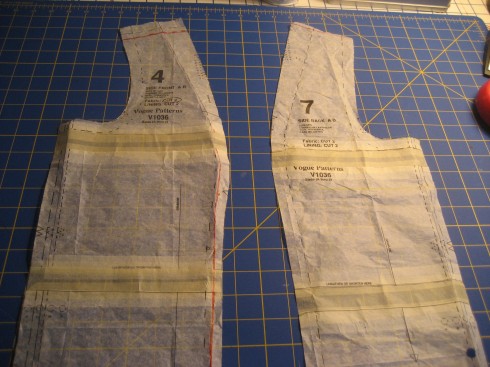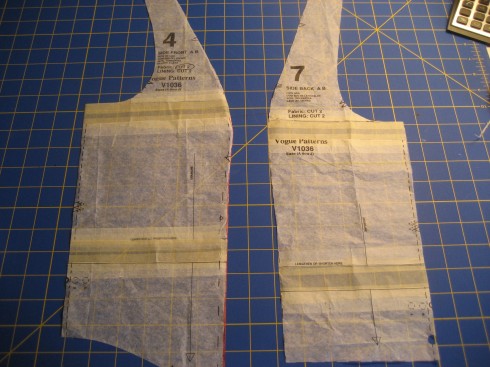I am making an attempt at sewing my third JAM jacket. This one will be Vogue 1036, this Sandra Betzina jean-style jacket:
 I’m using this heavy stretch cotton, stylized paisley fabric that I got from Marcy Tilton a few years ago:
I’m using this heavy stretch cotton, stylized paisley fabric that I got from Marcy Tilton a few years ago:
 It’s difficult to tell on the computer screen, but the colors are dark brown, navy blue, and light gray. I’m going to top stitch with a gray to somewhat match the gray in the fabric.
It’s difficult to tell on the computer screen, but the colors are dark brown, navy blue, and light gray. I’m going to top stitch with a gray to somewhat match the gray in the fabric.
Most of the things I sew are less fitted than this jacket, so I’m learning a lot from this very slow process. I always start by measuring the flat pattern at shoulder, waist, and hips. I have very narrow shoulders, so normally I will choose the smallest size (usually an eight) to fit in that area. Even then, I will have to make a narrow shoulder adjustment. I use to do a full bust adjustment, but discovered that if I simply go out a few sizes under the armscye (usually to a 10 or 12), it works better for me. For most of the knit tops I sew, those two adjustments are enough.
This time, I am working with princess seams, which is new to me. I couldn’t decide whether to adjust the shoulder from the armscye, or to take in the princess seams. I was worried that the 1 1/2 inch adjustment I had to make would put the princess seams too close to the shoulder seam if I adjusted at the armscye. I posted this dilemma on Stitcher’s Guild, and AnnR came to the rescue. She had made the same jacket and took in the princess seams to make the narrow shoulder adjustment. So, that was the first adjustment I made. I might add that Nancy Erickson, on the same post, thought that 1 1/2 inches would be too much to take in at the princess seam, and suggested I take half from the princess seam and half from the armscye. Armed with these two opinions, I chose to take all from the princess seam.
Next, I pinned the front and back pattern pieces together and tried it on. I noticed that there were two points that didn’t match, the bust point and the waist. I’ve never noticed this before, but I knew I couldn’t ignore it (much as I would like to). The crazy thing was that the bust point was too low and the waist was way to high. Ya gotta love body oddities. So I had to split the pattern (both front and back pieces) in two different places to make the adjustment – just below the armscye to make the bust point adjustment, and just above the waist to make the waist point adjustment.
I’m almost embarrassed to show my pattern pieces after the adjustment, but here is the naked truth of my sewing life:

As you can see, I don’t always trace the pattern before I make adjustments, but I usually trace the final, adjusted pattern piece. I figure, if my body changes, it’s better to go from the traced pattern piece that is always going to fit me through the shoulders, then I can just adjust the parts that are going to change with time.
So after I draw all of the cutting lines on the original pattern piece, with adjustments, I then cut all of the seam allowances off. It’s just easier for me to see the pattern this way. At this point, I deal with it as I would a BurdaStyle pattern. I trace it off, then add the seam allowance with my Olfa rotary cutter with seam gauge. If I were a really great sewist, I would thread trace the seams instead. Maybe some day. Here’s the final, adjusted pattern pieces.
 Of course, this is just the front and back side pieces. I had to alter the front and back front pieces in the same way.
Of course, this is just the front and back side pieces. I had to alter the front and back front pieces in the same way.
Now I’ll need to go through the facing pieces and see what needs fixing there. More to come.















 From left to right, the Abby Cardigan from StyleArc, the Creative Cate top (under the cardi) from StyleArc, Vogue 8435 raglan sleeve top, The Sewing Workshop Quincy top without pleats at the bust, another Vogue 8435 top, Cutting Line Design Discover Something Novel pants, and finally, Annie’s Cami from StyleArc.
From left to right, the Abby Cardigan from StyleArc, the Creative Cate top (under the cardi) from StyleArc, Vogue 8435 raglan sleeve top, The Sewing Workshop Quincy top without pleats at the bust, another Vogue 8435 top, Cutting Line Design Discover Something Novel pants, and finally, Annie’s Cami from StyleArc.

















 I’m using this heavy stretch cotton, stylized paisley fabric that I got from
I’m using this heavy stretch cotton, stylized paisley fabric that I got from 










Recent Comments